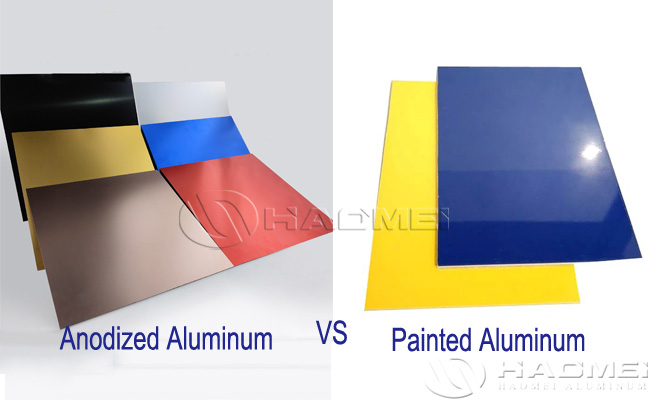Anodized aluminum and painted aluminum are two common aluminum surface treatments that differ significantly in process, performance, appearance, application and price.
The following is a detailed comparison of anodized aluminum vs painted aluminum:
- 1. The technical principle and process
Technical principle: through the anodic oxidation process, a dense layer of aluminum oxide film is formed on the surface of aluminum alloy sheet.
Process steps: pretreatment (such as cleaning, degreasing, alkali etching, etc.), anodic oxidation, dyeing (optional), sealing holes and post-treatment.
– Painted aluminum:
Technical principle: Coating one or more layers of organic paint on the surface of aluminum sheet or coil to form products with different colors and patterns.
Process steps: aluminum sheet pretreatment, coating selection, coating (such as roll coating, spraying, etc.), baking and curing, and so on.

- 2. Performance Characteristics
– Anodized aluminum:
Corrosion resistance: Aluminum oxide film has excellent corrosion resistance and can be used for a long time in harsh environments.
Abrasion resistance: high hardness, good scratch resistance, the surface is not easy to wear.
Weathering resistance: no color change for a long time indoors, and not easy to change color under long-term exposure to sunlight outdoors.
Metallic sense: retain the metal color, with a strong sense of metal texture.
Fire resistance: pure metal products, no combustion at high temperature, and no toxic gas release.
Processing: strong decorative, moderate hardness, easy to bend molding, convenient processing.
Corrosion resistance: depends on the quality and performance of the coating, high quality coating can provide better corrosion resistance.
Abrasion resistance: the surface of the coating is relatively soft, and the abrasion resistance is slightly worse than that of anodized aluminum.
Weathering resistance: also depends on the quality and performance of the coating, high quality coating can provide good weathering resistance.
Metallic feel: The metallic feel is relatively weak, but transparent or semi-transparent coatings are available to retain some of the metallic feel.
Fire resistance: depends on the fire rating of the coating material, and a coating that meets the requirements needs to be selected.
Processability: good processing performance, but affected by the thickness and hardness of the coating.
Color and pattern: Variable color and pattern to meet different design requirements.
- 3. Application Areas
– Anodized aluminum:
Widely used in construction, home, transportation, electronics and other fields. In the field of construction, it is commonly used in decorative parts such as curtain walls, doors, windows, ceilings, etc. In the field of home, it can be used in the manufacture of furniture, kitchen and bathroom appliances, etc. In the field of transportation, it can be used in internal and external decorative parts of automobiles, subways, high-speed railways and other means of transportation; in the field of electronics, it can be used in the shells of electronic products, radiators and other parts.
– Painted aluminum
Painted aluminum can also be used in construction, home appliances, transportation and other fields. In the field of construction, it is often used in the decoration of roof, wall and other parts; in the field of home appliances, it can be used in the shell of refrigerators, washing machines and other products; in the field of transportation, it can be used in the interior decoration of carriages, cabins and so on.
- 4. Cost and Price
– Anodized aluminum
Anodic oxidation process is relatively complex, high cost, so the product price is relatively high.
– Painted aluminum
Painted aluminum process is relatively simple, low cost, suitable for mass production, so the product price is relatively low.
In summary, anodized aluminum and painted aluminum have significant differences in the technical principle, performance characteristics, application areas, as well as the cost and price. The choice of material depends on specific needs, budget and performance requirements.
Contact Us
- 1103, No.14 Waihuan Road, CBD,Zhengzhou, China
- +86-0371-65621391
- nydia@aluminumhm.com
- Contact Form

